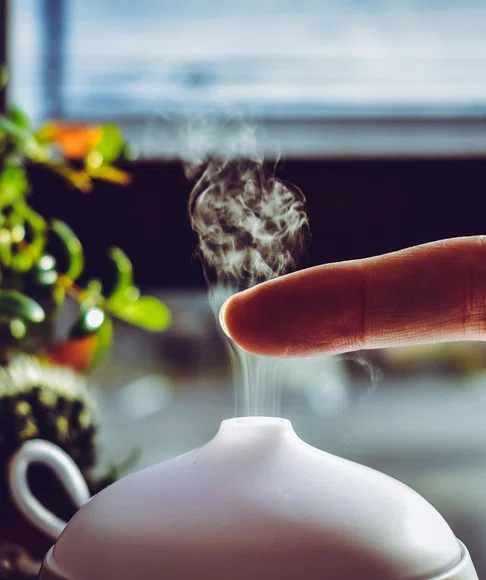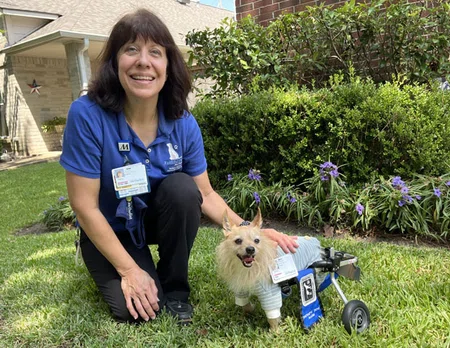© 2025. Houston Methodist, Houston, TX. All rights reserved.


In this
issue

WELCOME
NURSING SCIENCE

Holistic Care and the Use of Aromatherapy in Clinical Practice

Utilizing Music Therapy in Nursing Research
EDUCATION

Spiritual Care and Nursing Across the Houston Methodist System

Beyond Medicine: The Impact of Pet Therapy in Healthcare
PRACTICE

Narration of Care: A Bridge to Whole-Person Healing

Sweet Dreams, Sharp Minds: How Holistic Nursing and Sleep Hygiene Are Teaming Up to Tackle Delirium
PROFESSIONAL DEVELOPMENT
MAGNET
FROM OUR TEAMS

ABOUT DISCOVERN
NURSING SCIENCE
Holistic Care and the Use of Aromatherapy in Clinical Practice
By Joanne D. Muyco, DNP, RN, NE-BC, CNOR Nurse Scientist, Houston Methodist Hospital
By Joanne D. Muyco, DNP, RN, NE-BC, CNOR
Nurse Scientist, Houston Methodist Hospital
N
urses are experts in the art and science of patient care. While nursing science drives practice and interventions, the art of nursing involves a caring and healing approach that addresses the whole person—mind, body and spirit. The concept, often called holistic nursing, emphasizes compassion, empathy and self-awareness, and utilizes meaningful individualized interventions.1-2 Holistic nurses recognize the interdependence of mind, body and spirit, understanding that caring for all three can improve and optimize a person's quality of life. Holistic nursing also explores the relationships between the individual, their support systems and their environment.1,3 Through collaboration with the patient and interprofessional team, nurses can implement a variety of modalities to empower the whole person’s health trajectory and healthcare experience.
Holistic nursing interventions have proven effective in improving patient and family experience and overall quality and safety of care. These interventions are often non-pharmacologic and include alternative, integrative or complementary therapies, such as deep breathing, imagery, reflexology, massage and aromatherapy.2 Benefits have been observed across diverse patient populations—labor and delivery, perioperative, oncology, dialysis, palliative care and intensive care. Studies show reductions in pain, anxiety, nausea, vomiting, fatigue, labor duration and the prevention and treatment of delirium.4-11 The evidence supporting holistic nursing interventions is robust and continues to grow.
Aromatherapy is one of the most widely used holistic nursing interventions today, ranking as the second most common integrative method among nurses.12-13 With roots in ancient Egyptian, Mediterranean and Chinese cultures, aromatherapy has long been used in religious rituals, traditional medicine and healing practices.14 Aromatherapy is a non-pharmacologic intervention. It’s recognized as a mind-body therapy by the National Institutes of Health National Center for Complementary and Integrative Health. Aromatherapy uses essential oils, plant extracts and aromatic compounds to elicit therapeutic physiological, neurological and psychological responses.13-16
There are two primary categories:
Specific populations—such as the elderly, children, or patients with certain health conditions (e.g., G6PD deficiency, cardiac fibrillation)—may be especially vulnerable to certain essential oils used in aromatherapy.13-14 Proper storage and handling are also necessary to prevent adverse safety events. As aromatherapy use grows, evidence-based guidelines, policies, procedures, and regulations must be established to ensure safe and effective practice. Nurses must stay informed about current research and best practices to integrate aromatherapy responsibly into holistic care. Holistic care means treating the whole person—mind, body and spirit. Complementary and integrative therapies and interventions, such as aromatherapy, can benefit nurses addressing symptom management. Aromatherapy has proven to be effective in improving anxiety, pain, nausea and vomiting. Furthermore, aromatherapy is an easily applicable, readily available, cost-effective intervention that nurses can use in various clinical settings and patient populations. However, nurses must be aware of potential risks and contraindications to ensure safe use. When used appropriately, aromatherapy empowers nurses to deliver compassionate, whole-person care that improves outcomes and enriches the patient experience.
- Inhalation aromatherapy stimulates the olfactory system and prompts the brain to release neurotransmitters that promote relaxation.14,17
- Topical aromatherapy is absorbed, typically through the skin, triggering endorphins, pain relievers, and mood boosters that affect the body’s nervous system.14
Specific populations—such as the elderly, children, or patients with certain health conditions (e.g., G6PD deficiency, cardiac fibrillation)—may be especially vulnerable to certain essential oils used in aromatherapy.13-14 Proper storage and handling are also necessary to prevent adverse safety events. As aromatherapy use grows, evidence-based guidelines, policies, procedures, and regulations must be established to ensure safe and effective practice. Nurses must stay informed about current research and best practices to integrate aromatherapy responsibly into holistic care. Holistic care means treating the whole person—mind, body and spirit. Complementary and integrative therapies and interventions, such as aromatherapy, can benefit nurses addressing symptom management. Aromatherapy has proven to be effective in improving anxiety, pain, nausea and vomiting. Furthermore, aromatherapy is an easily applicable, readily available, cost-effective intervention that nurses can use in various clinical settings and patient populations. However, nurses must be aware of potential risks and contraindications to ensure safe use. When used appropriately, aromatherapy empowers nurses to deliver compassionate, whole-person care that improves outcomes and enriches the patient experience.
References:
- Frisch, N.C. & Rabinowitsch, D. (2019). What’s in a definition? Holistic nursing, integrative health care, and integrative nursing: Report of an integrated literature review. Journal of Holistic Nursing, 37(3), 260-272. https://doi.org/10.1177/0898010119860685
- Thornton, L. (2019). A brief history and overview of holistic nursing. Integrative Medicine, 18(4), 32-33.
- Kalb, K.A. & O’Conner-Von, S. (2019). Holistic nursing education: Teaching in a holistic way. Nursing Education Perspectives, 40(3), 162-164. https://doi.org/10.1097/01.NEP.0000000000405
- Jun, J., Kapella, M.C., & Hershberger, P.E. (2021). Non-pharmacological sleep interventions for adult patients in intensive care units: A systematic review. Intensive & Critical Care Nursing, 67, 103124. https://doi.org/10.1016/j.iccn.2021.103124
- Lee, Y., Lee, J., Kim, J., & Jung, Y. (2021). Non-pharmacological nursing interventions for prevention and treatment of delirium in hospitalized adult patients: Systematic review of randomized controlled trials. International Journal of Environmental Research and Public Health, 18(16), 10.3390/ijerph18168853
- Domínguez-Solís, E., Lima-Serrano, M., & Lima-Rodríguez, J.S. (2021). Non-pharmacological interventions to reduce anxiety in pregnancy, labour and postpartum: A systematic review. Midwifery, 102, 103126. https://doi.org/10.1016/j.midw.2021.103126
- Tola, Y.O., Chow, K.M., & Liang, W. (2021). Effects of non-pharmacological interventions on preoperative anxiety and postoperative pain in patients undergoing breast cancer surgery: A systematic review. Journal of Clinical Nursing, 30(23-24), 3369-3384. https://doi.org/10.1111/jocn.15827
- Toniolo, J., Delaide, V. & Beloni, P. (2021). Effectiveness of inhaled aromatherapy on chemotherapy-induced nausea and vomiting: A systematic review. Journal of Alternative and Complementary Medicine, 27(12), 1058-1069. https://doi.org/10.1089/acm.2021.0067
- Abushukur, Y., Cascardo, C., Ibrahim, Y., Teklehaimanot, F., & Knackstedt, R. (2022). Improving breast surgery outcomes through alternative therapy: A systematic review. Cureus, 14(3), e23443. https://doi.org/10.7759/cureus.23443
- Bayülgen, M.K. & Gün, M. (2022). Effect of complementary and integrative treatments on fatigue symptoms in hemodialysis patients: A systematic review. Holistic Nursing Practice, 36(1), 17-27. https://doi.org/10.1097/HNP.0000000000000489
- Van Veen, S., Drenth, H., Hobbelen, H., Finnema, E., Teunissen, S., & de Graaf, E. (2024). Non-pharmacological interventions feasible in the nursing scope of practice for pain relief in palliative care patients: A systematic review. Palliative Care and Social Practice, 18. https://doi.org/10.1177/26323524231222496
- Fayazi, S., Babashahi, M., & Rezaei, M. (2011). The effect of inhalation aromatherapy on anxiety level of the patients in preoperative period. Iran Journal of Nursing and Midwifery Research, 16(4), 278-283.
- Farrar, A.J. & Farrar, F.C. (2020). Clinical aromatherapy. Nursing Clinics of North America, 55(4) 489-504. https://doi.org/10.1016/j.cnur.2020.06.015
- Vora, L.K., Gholap, A.D., Hatvate, N.T., Naren, P., Khan, S., Chavda, V.P., Balar, P.C., Gandhi, J., & Khatri, D.K. (2024). Essential oils for clinical aromatherapy: A comprehensive review. Journal of Ethnopharmacology, 330, 118180. https://doi.org/10.1016/j.jep.2024.118180
- Her, J. & Cho, M.K. (2021). Effect of aromatherapy on sleep quality of adults and elderly: A systematic literature review and meta-analysis. Complementary Therapies in Medicine, 60, 102739. https://doi.org/10.1016/j.ctim.2021.102739
- Ghiasi, A., Bagheri, L., & Sharaflari, F. (2022). Effectiveness of aromatherapy in reducing duration of labour: A systematic review. Journal of Obstetrics and Gynaecology, 42(7), 2573-2582. https://doi.org/10.108/01443615.2022.2109952
- Guo, P. Li, P., Zhang, X, Liu, N., Wang, J., Yu, L., & Zhang, W. (2020). The effectiveness of aromatherapy on preoperative anxiety in adults: A systematic review and meta-analysis of randomized controlled trials. International Journal of Nursing Studies, 111, 103747. https://doi.org/10.1016/j.ijnurstu.2020.103747
- Asay, K., Olson, C., Donnelly, J., & Perlman, E. (2018). The use of aromatherapy in postoperative nausea and vomiting: A systematic review. Journal of PeriAnesthesia Nursing, 34(3), 502-516. https://doi.org/10.1016/j/jopan.2018.08.006
- Liao, C.C., Lan, S.H., Yen, Y.Y., Hsieh, Y.P., & Lan, S.J. (2021). Aromatherapy intervention on anxiety and pain during first stage labour in nulliparous women: A systematic review and meta-analysis. Journal of Obsetrics and Gynaecology, 41(1), 21-31. https://doi.org/10.1080/01443615.2019.1673707










